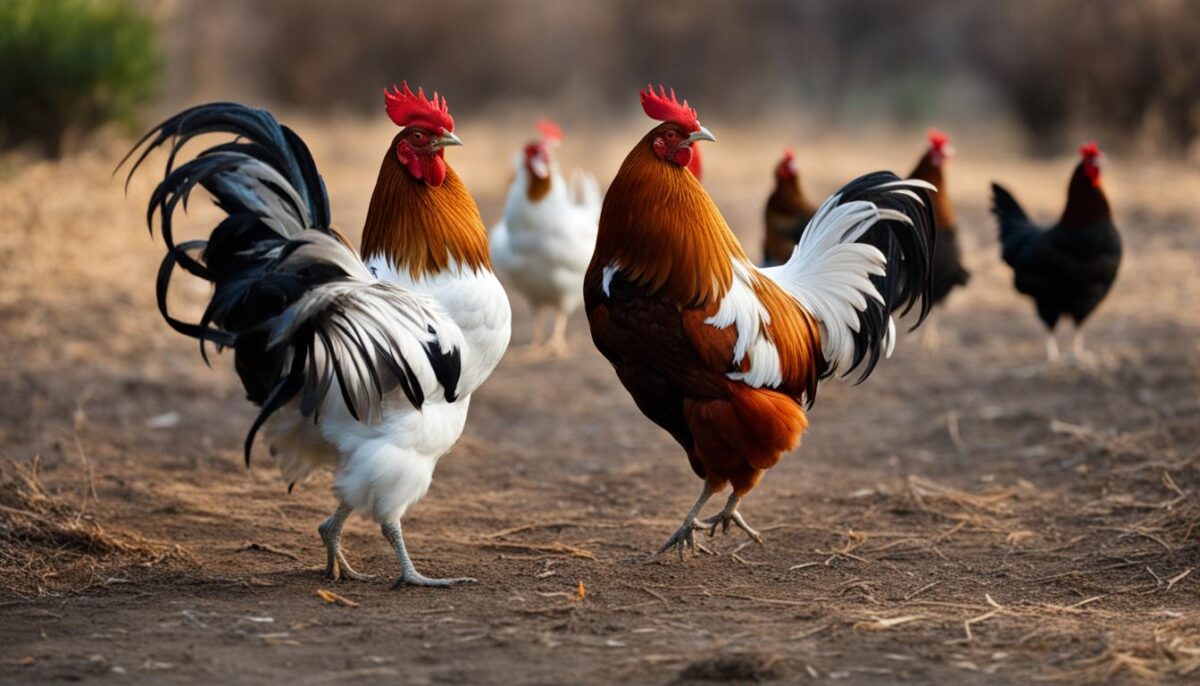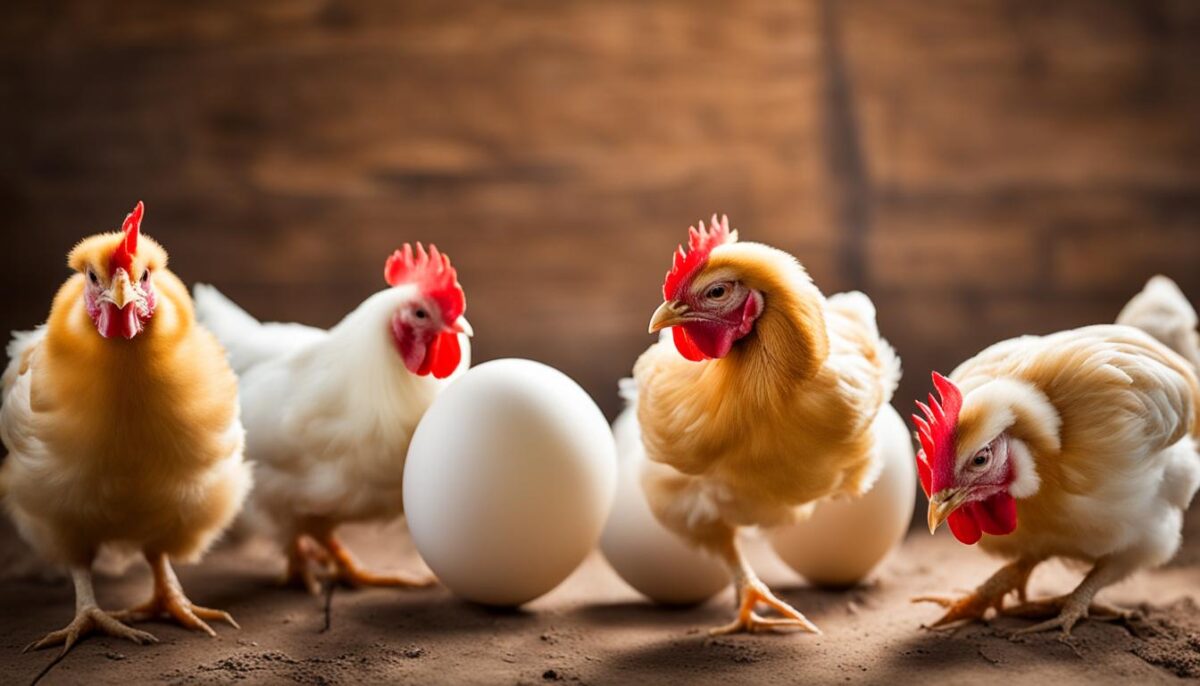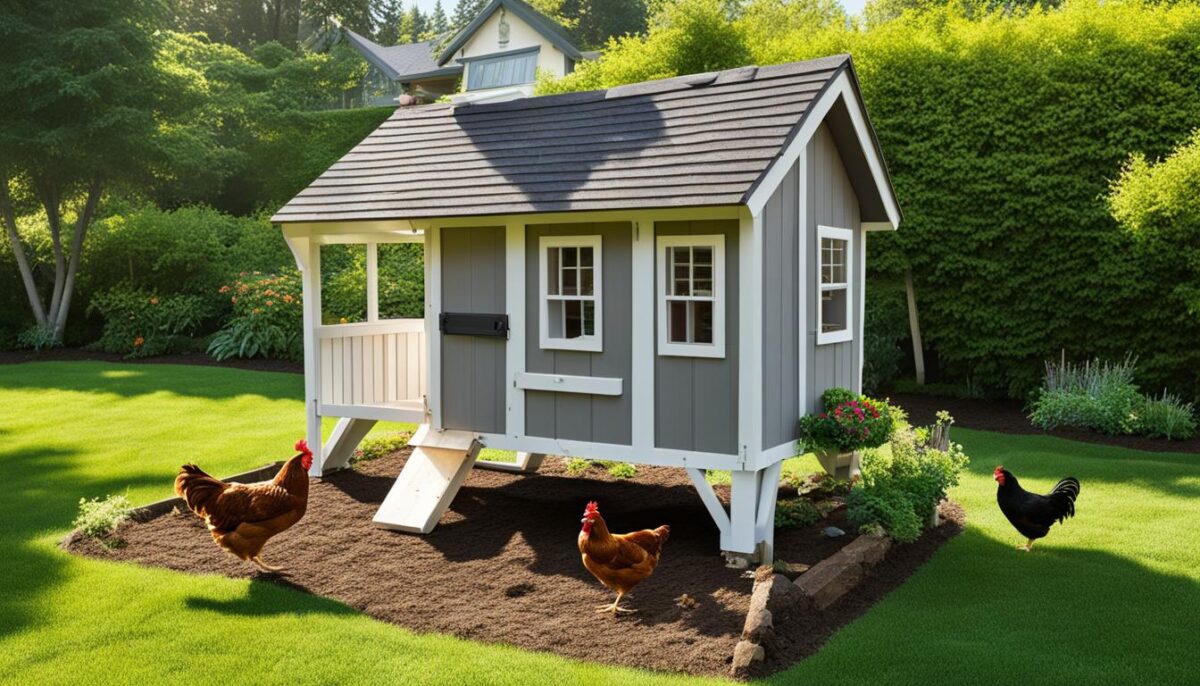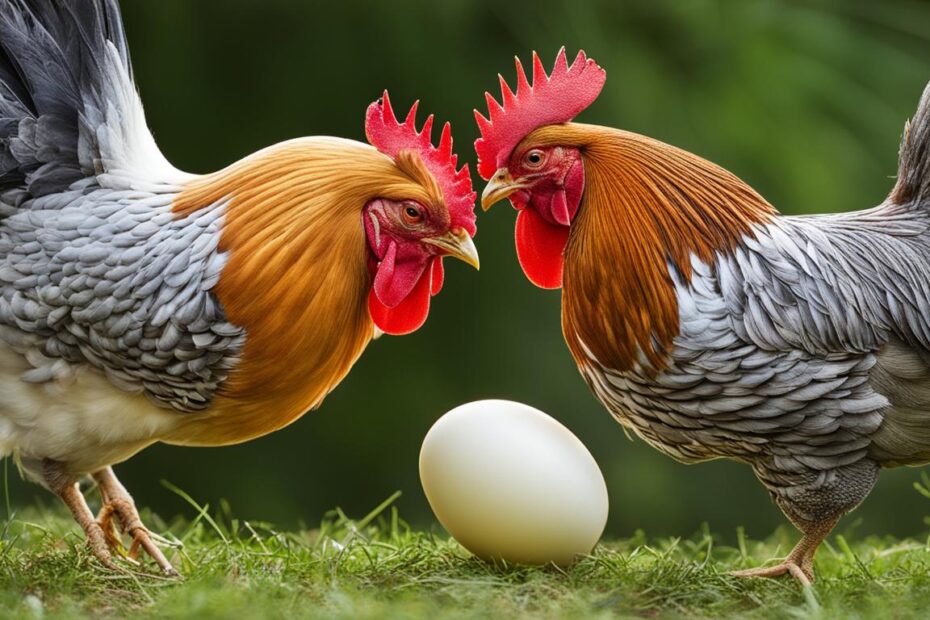Chickens, like many other animals, have a unique reproductive process. Unlike mammals, chickens do not require a rooster’s presence to lay eggs. This has practical implications for both urban and commercial chicken keepers. In this article, we delve into the fascinating process of chicken reproduction, exploring their mating behavior, reproductive anatomy, and the advantages of their unique physiology.
Key Takeaways:
- Chickens can reproduce sexually without a rooster’s presence.
- The mating process involves a quick exchange of sperm through a “cloacal kiss.”
- The cloaca, a unique organ in chickens, serves as the exit for feces, eggs, and the entrance for sperm.
- Understanding the reproductive anatomy of chickens helps in comprehending their reproduction process.
- Chickens do not produce liquid urine, which has several advantages like lighter body weight and minimal coop cleaning needs.
Chicken Reproductive Anatomy
The reproductive anatomy of chickens plays a crucial role in their unique reproductive process. Understanding the structure and function of their reproductive system provides insights into how chickens are able to reproduce sexually without the presence of a rooster.
Female chickens have a cloaca, which is a single rear orifice that serves multiple functions. It acts as the exit for feces, eggs, and the entrance for sperm. The oviduct of a hen inverts within the cloaca to ensure minimal contact between feces and eggs. This adaptation helps maintain the cleanliness and integrity of the eggs. On the other hand, the male chicken, or rooster, also has a cloaca but its functions are limited to passing feces and transferring sperm to the female.
Male Reproductive Anatomy
The male reproductive anatomy of chickens consists of the testes, which produce sperm, and the cloaca, through which the sperm is transferred to the female during mating. The cloaca of the rooster has a duct called the vas deferens that carries sperm from the testes to the cloacal opening. During mating, the rooster’s cloaca makes contact with the female’s cloaca, and a quick exchange of sperm occurs through a process known as a “cloacal kiss.”
Female Reproductive Anatomy
The female reproductive anatomy of chickens includes the ovary, where the yolks are produced, and the oviduct, the organ responsible for the formation of the egg. The oviduct is a long, convoluted tube that consists of five regions – infundibulum, magnum, isthmus, shell gland, and vagina. Each region plays a specific role in the formation and development of the egg.
The infundibulum is the site of fertilization, where the sperm and yolk meet. The magnum is where the egg white is deposited around the yolk. The isthmus is responsible for the formation of the shell membranes. The shell gland is where the shell is formed and hardened. Finally, the egg is laid through the vagina.
Chicken Mating Behavior
Understanding the mating behavior of chickens provides insights into their reproductive process. Before mating, the rooster often engages in a type of pre-mating behavior known as “courtship.” This includes prancing around the hen, clucking, and sometimes even presenting food offerings. These actions serve to attract the hen’s attention and establish dominance within the flock.
When the mating process begins, the rooster mounts the hen from behind, positioning himself on her back. It is important to note that the mating process in chickens does not involve penetration as seen in mammals. Instead, a quick exchange of sperm takes place through a unique method known as a “cloacal kiss.” The cloacas (the external openings that serve as the exit for feces and the entrance for sperm) of the male and female chickens come into contact, and sperm is transferred from the rooster to the hen.
“The mating process in chickens is fascinating to observe. The rooster’s elaborate courtship behavior and the swift exchange of sperm through the cloacal kiss are unique characteristics of chicken reproduction.”
Roosters play a crucial protective role in the flock after mating. They remain vigilant and are known to defend their hens from intruders and potential threats. This behavior ensures the safety and well-being of the hens during the breeding cycle.
Chicken Mating Behavior: Key Points to Remember
- Courtship behavior involves prancing, clucking, and food offerings by the rooster.
- The mating process does not involve penetration but rather a “cloacal kiss” for the exchange of sperm.
- Roosters protect their hens from intruders during the breeding cycle.
The mating behavior of chickens showcases the unique adaptations and behaviors specific to their reproductive process. By understanding these behaviors, chicken keepers can gain a deeper appreciation for the intricate dynamics of their flock and provide optimal care for their feathered friends.

Fertilization Process in Chickens
The fertilization process is a crucial step in chicken reproduction, as it is the moment when the sperm meets the egg, setting the stage for the development of a new chick. After the sperm is transferred to the hen through a “cloacal kiss,” the eggs travel through the reproductive organs, where fertilization occurs. The process begins in the ovary, where the eggs start as yolks. From there, they pass into the infundibulum, the first section of the oviduct, where fertilization takes place.
As the eggs move through the oviduct, they undergo various stages of development. In the magnum, the egg white forms and gathers around the yolk. Next, in the isthmus, the shell membranes are formed. Finally, in the shell gland, the shell is formed and hardened. The entire process takes around 24 hours, and the fertilized egg is then ready to be laid.
Understanding the fertilization process in chickens is essential for chicken keepers and breeders, as it allows them to ensure proper breeding conditions and monitor the development of the eggs. By providing a suitable environment and nutrition, chicken owners can support the healthy growth of the chick inside the egg.
Table: Stages of Egg Development in Chickens
| Stage | Location | Duration |
|---|---|---|
| Yolk formation | Ovary | Approximately 10 to 12 days |
| Fertilization | Infundibulum | Within 15 minutes of sperm transfer |
| Egg white formation | Magnum | Approximately 3 hours |
| Shell membrane formation | Isthmus | Approximately 1.5 hours |
| Shell formation | Shell gland | Approximately 20 hours |
Chicken Breeding Cycle, Fertilized Eggs, and Egg Incubation
Understanding the chicken breeding cycle is essential for successful egg production and hatching. The process starts with mating between a rooster and a hen, where the rooster transfers sperm to the hen through a cloacal kiss. Fertilization occurs when the sperm meets the eggs in the hen’s reproductive system. Once the eggs are fertilized, they undergo a 21-day incubation period, during which the embryos develop inside the eggs.
During the incubation process, the eggs require specific temperature and humidity levels to ensure proper development. Many chicken breeders use artificial incubators to provide optimal conditions for the eggs. It’s essential to monitor and maintain these conditions consistently to increase the chance of successful hatching. Regular turning of the eggs during incubation helps prevent the embryos from sticking to the shell and promotes their healthy development.
It’s important to note that not all eggs laid by hens are fertilized. In commercial egg production, roosters are typically not present, resulting in unfertilized eggs. However, in smaller or hobby flocks where roosters are present, the eggs have the potential to be fertile. These fertilized eggs can be used for incubation, allowing for the natural hatching of chicks.
| Stage | Duration |
|---|---|
| Egg laying | 24-26 hours per egg |
| Fertilization | Immediate after mating |
| Incubation | 21 days |
| Hatching | 24-48 hours after incubation |
“The chicken breeding cycle involves a delicate interplay of mating, fertilization, and incubation. Understanding and managing these processes are crucial for successful chicken breeding and hatching.” – Chicken Breeding Expert
Overall, the chicken breeding cycle, fertilized eggs, and egg incubation are fascinating aspects of chicken reproduction. By carefully managing these processes, chicken keepers can ensure a healthy breeding cycle and the potential for adorable new additions to their flocks.

Rooster and Hen Mating: Understanding the Chicken Breeding Cycle
The mating between a rooster and a hen plays a crucial role in the chicken breeding cycle. Unlike mammals, the mating process in chickens is unique and involves a quick exchange of sperm through what is known as a “cloacal kiss.” This behavior is when the cloacas, the reproductive and waste organs of the male and female chickens, come into contact, allowing the transfer of sperm. It is important to note that hens do not need to mate daily to lay fertile eggs. The stored sperm in their bodies can keep their eggs fertile for up to a couple of weeks or longer, ensuring a proper breeding cycle.
When it comes to maintaining a flock, the rooster to hen ratio is essential. A single rooster can effectively mate with and keep about eight to a dozen hens fertile. This ratio not only ensures successful fertilization but also avoids overcrowding in the flock. It allows chicken keepers to manage their flock sizes without the need for multiple roosters, ensuring a balanced and controlled breeding environment.
Understanding the mating habits of roosters and hens and their role in the chicken breeding cycle is crucial for successful chicken keeping. By carefully managing the rooster to hen ratio, chicken keepers can maintain a healthy and productive flock, ensuring a consistent supply of fertile eggs for breeding and incubation.
Mating Frequency Chart
| Rooster to Hen Ratio | Mating Frequency |
|---|---|
| 1 rooster to 8 hens | Regular mating ensures fertile eggs |
| 1 rooster to 12 hens | Regular mating ensures fertile eggs |
| 1 rooster to 20 hens | Reduced mating frequency may result in lower fertility rates |
Advantages of No Liquid Urine
Unlike mammals, chickens have a unique adaptation in their urinary system. They do not produce liquid urine, but instead eliminate waste through their cloaca as a form of moist chicken feces coated with uric acid. This distinct characteristic of chickens offers several advantages.
“Chickens eliminate waste through their cloaca as a form of moist chicken feces coated with uric acid.”
One advantage is that chickens have lighter bodies compared to mammals. The absence of liquid urine reduces the overall weight, allowing chickens to be more agile and capable of flight. This adaptation enables them to escape predators or roost in higher areas for safety.
Another advantage is the convenience it provides for chicken keepers. The lack of liquid urine means that their coop stays dryer for longer periods. The moist chicken feces quickly dries and becomes incorporated into the bedding, minimizing the need for frequent coop cleaning. This not only saves time and effort for chicken keepers but also helps maintain a cleaner and odor-free environment for the chickens.
Advantages of No Liquid Urine in Chickens:
- Lighter bodies, enabling flight and agility
- Reduced need for frequent coop cleaning
- Minimized odor and cleaner environment
Overall, the lack of liquid urine in chickens offers significant advantages in terms of their physical capabilities and the convenience it provides for chicken keepers. These unique adaptations contribute to the success of chicken reproduction and make chicken keeping more manageable and enjoyable for enthusiasts in both urban and rural settings.

Overall, chicken reproduction in urban settings opens up possibilities for individuals who are passionate about sustainable living, self-sufficiency, and connecting with nature. The ability to keep hens without the need for a rooster and the absence of liquid urine production make backyard chicken keeping practical and enjoyable, even in densely populated areas.
Nutrena’s Poultry Products
Nutrena offers a wide range of high-quality poultry products designed to support optimal egg production and overall bird well-being. With a focus on providing complete and balanced nutrition, Nutrena’s specialized feeds are formulated to meet the unique requirements of chickens at various stages of their life cycle. Whether you are raising chicks, caring for laying hens, or managing a broiler operation, Nutrena has the right feed to help you achieve your goals.
Nutrena’s poultry feeds are made from premium ingredients and undergo rigorous testing to ensure their quality and safety. The feeds are formulated with essential nutrients, including vitamins, minerals, and amino acids, to support healthy growth, strong immune function, and productive egg laying. Nutrena also offers specialized feeds such as organic, non-GMO, and antibiotic-free options, allowing chicken keepers to meet their specific preferences and requirements.
In addition to their high-quality feeds, Nutrena provides innovative solutions for coop cleanliness. Their coop products help maintain a clean and odor-free environment, promoting the overall health and well-being of your flock. Nutrena’s coop products include bedding materials, coop cleaners, and odor control solutions. These products are designed to keep your coop fresh and comfortable, reducing the risk of pests and diseases.
| Product | Benefits |
|---|---|
| Layer Feed | Supports optimal egg production and shell quality |
| Chick Starter | Provides essential nutrients for healthy chick growth |
| Broiler Feed | Promotes efficient growth and meat production in broilers |
| Organic Feed | Meets organic standards and provides natural nutrition |
| Non-GMO Feed | Offers a non-genetically modified alternative |
| Coop Bedding | Creates a comfortable and clean environment for your flock |
| Coop Cleaner | Helps maintain a hygienic coop and reduce the risk of diseases |
| Odor Control | Minimizes coop odors for a pleasant and healthy living space |
By choosing Nutrena’s poultry products, you can ensure that your chickens receive the nutrition they need to thrive and produce high-quality eggs. With a commitment to excellence and a focus on the well-being of your flock, Nutrena is a trusted brand among chicken keepers. Elevate your chicken keeping experience with Nutrena’s high-quality feeds and innovative coop solutions.
Top Online Casinos in Australia
When it comes to online gambling, finding the best online casinos in Australia is crucial for a safe and enjoyable experience. With the abundance of options available, it can be overwhelming to choose the right casino. To help you make an informed decision, we have compiled a list of the top online casinos in Australia that offer a wide variety of games, generous bonuses, and a reliable gambling environment.
These online casinos provide a diverse range of games to cater to every player’s preference. Whether you’re a fan of classic table games like blackjack and roulette or prefer the excitement of slot games, you’ll find plenty of options to choose from. Each casino on our list is licensed and regulated, ensuring fair gameplay and secure transactions.
Additionally, these top online casinos in Australia offer attractive bonuses to enhance your gaming experience. From welcome bonuses to free spins and loyalty programs, players can take advantage of these promotions to maximize their winnings and prolong their gameplay. It’s important to note that each casino has its own terms and conditions for bonuses, so be sure to read them carefully.
| Top Online Casinos in Australia | Bonus Offer | Game Selection | License |
|---|---|---|---|
| Casino A | 100% up to $1000 + 100 Free Spins | Slots, Blackjack, Roulette | Licensed and regulated by XYZ |
| Casino B | $1500 Welcome Package | Table Games, Live Casino | Licensed and regulated by ABC |
| Casino C | 200% up to $200 + 50 Free Spins | Slots, Poker | Licensed and regulated by DEF |
It’s essential to choose an online casino that is licensed and regulated by reputable authorities to ensure fair gameplay and the security of your personal and financial information. We recommend doing your research and reading reviews from other players before making a decision. Remember to gamble responsibly and set limits for yourself to ensure a positive and enjoyable online gambling experience.
Starting Your Gambling Journey
Are you ready to embark on a thrilling gambling adventure? Look no further than the top online casinos in Australia. Whether you’re a seasoned player or just starting out, these online casinos offer a wide range of games to suit every preference. From exciting slot games to classic table games, there’s something for everyone.
When starting your gambling journey, it’s important to choose a reputable online casino that provides a safe and reliable gaming experience. The top online casinos in Australia prioritize player safety and security, ensuring that your personal information is protected and your transactions are secure.
Once you’ve chosen an online casino, making your first deposit is easy. Simply follow the casino’s instructions for depositing funds into your account and you’ll be ready to start playing. Many online casinos also offer generous welcome bonuses to new players, giving you extra funds to explore the games and increase your chances of winning.

Advantages of Playing at Online Casinos
Playing at online casinos offers several advantages that make it a popular choice for gambling enthusiasts. One of the main advantages is convenience. You can access your favorite casino games from the comfort of your own home, allowing you to play anytime, anywhere.
Online casinos also provide a wide variety of games to choose from. Whether you enjoy slots, blackjack, roulette, or poker, you’ll find a diverse selection of games at the top online casinos in Australia. These casinos are powered by leading software providers, ensuring high-quality graphics and immersive gameplay.
Additionally, online casinos often offer lucrative bonuses and promotions to enhance your gaming experience. From welcome bonuses to free spins, these promotions give you the chance to win additional prizes and extend your playtime. Keep an eye out for the latest promotions at your chosen online casino to make the most of your gambling journey.
Conclusion
In conclusion, chickens have a fascinating process of sexual reproduction that sets them apart from mammals. They are capable of laying eggs without the presence of a rooster, making chicken keeping feasible in urban and suburban areas. The mating behavior in chickens involves a unique “cloacal kiss” where sperm is exchanged through the touch of cloacas, rather than the traditional penetration seen in mammals.
Understanding the reproductive anatomy of chickens is key to comprehending their reproduction process. Female chickens have a cloaca, a multi-purpose organ that serves as the exit for feces and eggs, as well as the entrance for sperm. The male chicken, or rooster, also has a cloaca, but it only functions in passing feces and transferring sperm to the female. This anatomical adaptation allows for efficient reproduction in chickens.
In addition to the reproductive process, Nutrena offers high-quality poultry products to support optimal egg production and overall bird well-being. These specialized feeds provide essential nutrients and innovative solutions for coop cleanliness, making chicken keeping easier and more enjoyable for enthusiasts. Whether you’re interested in chicken reproduction or online gambling, these topics provide unique insights and options for enthusiasts in their respective fields.
FAQ
How do chickens reproduce sexually?
Chickens reproduce sexually through a process called mating, where a rooster transfers sperm to a hen through a “cloacal kiss” exchange. The hen then fertilizes her eggs with the transferred sperm.
What is the reproductive anatomy of chickens?
Female chickens have a cloaca, a single rear orifice that serves as the exit for feces and eggs and the entrance for sperm. Male chickens also have a cloaca, which functions to pass feces and transfer sperm to the female.
How do chickens mate?
Before mating, the rooster engages in a type of foreplay, prancing around the hen and clucking. The actual mating process involves a quick exchange of sperm through a “cloacal kiss,” where the cloacas of the male and female touch and sperm is exchanged.
What is the fertilization process in chickens?
After mating, the hen’s eggs pass through the oviduct and are fertilized by the sperm in the infundibulum. The egg then undergoes development in the reproductive organs of the female, where the egg white gathers around the yolk, shell membranes form, and the shell is formed and hardened.
Are all eggs laid by hens fertile?
No, not every egg laid by a hen is fertile. For an egg to be fertile, the hen must have mated with a rooster before the egg was formed. Most eggs available in supermarkets are unfertilized, as roosters are not typically present in commercial egg production operations.
How long can hens store sperm?
Hens can store sperm in their bodies, allowing their eggs to remain fertile for at least a couple of weeks, and in some cases even longer, before re-mating is necessary. One rooster can effectively keep eight to a dozen hens fertile, ensuring a proper breeding cycle.
Why do chickens not have liquid urine?
Chickens do not produce liquid urine like mammals. Instead, they eliminate waste through their cloaca as a form of moist chicken feces coated with uric acid. This adaptation allows chickens to have lighter bodies and prevents the need for excessive coop cleaning.
Can chickens be kept in urban areas?
Yes, chickens can be kept in urban areas. The ability of chickens to lay eggs without a rooster and their lack of liquid urine production make backyard chicken keeping feasible in urban and suburban settings.
What poultry products does Nutrena offer?
Nutrena offers a range of high-quality poultry products, including specialized feeds designed to support optimal egg production and overall bird well-being. They also provide innovative solutions for coop cleanliness, helping to maintain a clean and odor-free environment for backyard flocks.
What are the top online casinos in Australia?
The top online casinos in Australia provide a safe and reliable gambling experience, catering to both seasoned players and beginners. These casinos offer a wide selection of games and generous bonuses, making them suitable for a variety of players.
How do I start my gambling journey?
To start your gambling journey, choose one of the top online casinos in Australia from our list. Make your first deposit and begin exploring the exciting world of online gambling, whether you prefer slot games or classic table games.


